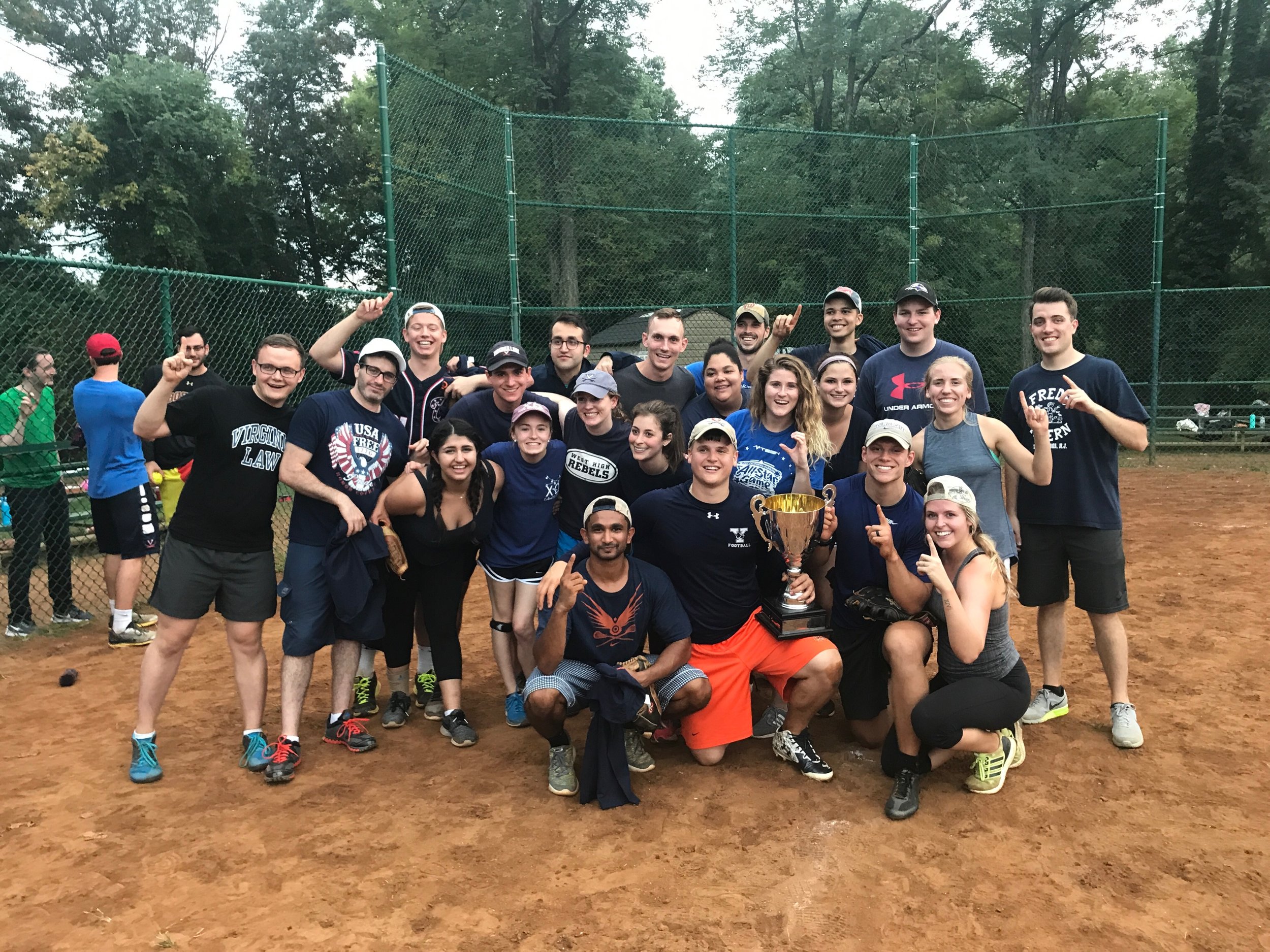Kimberly Hopkin '19
(she/her/hers)
Columns Editor
Section C, 1L softball champions, pose for a photograph. Photo courtesy of Kim Hopkin.
This past Sunday at Copeley Field, North Grounds Softball League (NGSL) hosted the 1L Softball Tournament, which pitted the 1L Sections and the LLM Section against each other to determine a champion. Jonathan York, Head Commissioner of NGSL and Head PA, explains the purpose behind the tournament as “an opportunity to form close friendships both inside and outside of [the] 1L sections.” Indeed, a “perfect break from the stresses of starting 1L,” this year’s tournament was impressively run. The bracket was determined based on Dandelion results and the outcomes of each team’s first regular-season game.
The tournament started at 9:00 a.m. with the #7 seeded team, Section C’s Cases Loaded, competing against the #10 seeded team, Section E’s Liabilit-E’s. Cases Loaded pulled ahead winning 7-6 and advanced to the next round. At 10:00 a.m., the #6 and #11 seeded teams played with Section B’s Bad News Bearisters securing a decisive victory against the LLMs1 outscoring them 9-5. Section G’s Grand Slamicus and Section F’s F is for Phenomenal commenced their offensively impressive game at 11:00 am; Grand Slamicus managed to secure a victory by scoring a hotly contested run during extra innings after the teams were tied at 9. When the Moe’s BBQ arrived at noon, Cases Loaded headed back on the field to challenge the #2 seeded team, Section I’s Inglawrious Batters. While there was some initial back and forth over the lead, Cases Loaded came roaring back to pull off an upset, winning 11-7. Bad News Bearisters then had to face off against the #3 seeded team, Section J’s Juris Daddies. The fact that Bad News Bearisters won 14-5 was indicative of the game in general. At 2:00 p.m., Section D’s Do It for the JD managed to best Grand Slamicus winning 9-8. Completing the last quarterfinal at 3:00 p.m., Section A’s Accidentally in Law dominated over Section H’s Hoos on First? by shutting them out 7-nothing with a stifling defense.
Heading into the semifinals, Accidentally in Law completed a double-header against Do It for the JD. Benefitting from some clutch hitting up and down their lineup, Accidentally in Law prevailed over Do It for the JD 5-3. Bad News Bearisters and Cases Loaded faced off at 5:00 p.m. Reinvigorated after the break,2 Cases Loaded triumphed over Bad News Bearisters through a combination of impressive outfielding and base-clearing home runs, winning 9-5. Cases Loaded celebrated briefly and exuberantly as Accidentally in Law prepared their strategy under the shade of trees at the far end of the field.
Photo courtesy of Kim Hopkin.
The final started at 6:00 pm—a double-header for Cases Loaded. In the games leading up, Accidentally in Law adhered to the 1L tournament spirit to play all section members who wanted to play, while Cases Loaded opted for the “best ten players will play” strategy. The atmosphere still elicited the sense that Cases Loaded was an underdog. Playing the first game of the tournament and dressed in mismatched blue shirts compared to Accidentally in Law’s late start time and polished jerseys certainly added to that impression. Accidentally in Law exhibited a strong defense and notable team leadership under captains Eleanor Schmalzl3 and Peter Dragna. The first inning reflected Accidentally in Law’s strength, as they pushed ahead with a 6-4 lead. However, as the Cases Loaded team captain Reese Gwin stated, “It was all about having fun—until we got to the championship. Then, it was only about winning.” That competitive attitude served the team well as Cases Loaded managed to shut the opposing team out for the next five consecutive innings. Accidently in Law slipped defensively in the third and fifth innings allowing Cases Loaded to pull ahead 10-6. Feeling the pull of defeat, Accidentally in Law strategically forced the end of the sixth inning to start a seventh inning.4 After some incredulous pushback from Cases Loaded fans5 about a new inning starting fifty-four minutes into the game, Cases Loaded team captain Jackson Stallings energized Cases Loaded players and fans alike by assuring them that, with continued effort, victory would be theirs. Seizing that slight momentum, Cases Loaded scored an additional run in the top of the seventh inning. That’s not to say that Accidentally in Law didn’t exhibit some exemplary defensive moments during the last inning. Heading into the bottom of the seventh inning, Accidentally in Law scored an early run, but, unfortunately for them, were ultimately unable to capitalize on this momentum. Cases Loaded became the champions winning 11-7.
When asked about the win, Cases Loaded team captains stated that the team’s tenacity depended on a feeling of comradery and trust within the section: “We knew we had to have each other’s backs, and we did. We are all we have.” They also credited their non-playing section mates and PAs for supplying solid cheers and chants6 that energized the team throughout the day. And with that, both teams shook hands, retired their gloves and bats, and headed to the library to complete an impending LRW assignment.7
---
knh3zd@virginia.edu
Contributions courtesy of Eleanor Schmalzl
mes5hf@virginia.edu
1 Seemingly nameless.
2 And in search of further procrastination of LRW assignments according to some team members.
3 Proud Law Weekly staff member.
4 NGSL regulations restrict umpires from allowing the start of a new inning more than 55 minutes into the game. Accidentally in Law denies the allegation.
5 Mostly Section C PAs.
6 As well as pizza and "unbelievable dance moves."
7 And for Cases Loaded, to showcase their winning trophy to leave no doubt in their classmates’ minds who the winners were.












